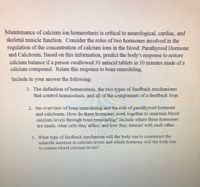
Human Anatomy & Physiology (11th Edition)
11th Edition
ISBN: 9780134580999
Author: Elaine N. Marieb, Katja N. Hoehn
Publisher: PEARSON
expand_more
expand_more
format_list_bulleted
Concept explainers
Question
See attachment

Transcribed Image Text:**Understanding Calcium Ion Homeostasis and Bone Remodeling**
The maintenance of calcium ion homeostasis is vital for neurological, cardiac, and skeletal muscle function. This section explores the roles of two critical hormones in regulating blood calcium levels: Parathyroid Hormone (PTH) and Calcitonin.
**Predicting the Body's Response to Calcium Intake:**
When an individual ingests a high calcium load, such as swallowing 30 antacid tablets composed of calcium compounds within 10 minutes, the body must restore calcium balance. The response involves both immediate and long-term mechanisms related to bone remodeling.
### Key Concepts to Address:
1. **Definition of Homeostasis:**
Homeostasis refers to the body's ability to maintain a stable internal environment despite external changes. This involves two types of feedback mechanisms:
- **Negative Feedback**: Reduces the output or activity to return to an ideal level of a variable.
- **Positive Feedback**: Increases the output or activity to move further away from an initial state.
Components of a feedback loop include the stimulus, receptor, control center, effector, and response.
2. **Overview of Bone Remodeling and Hormonal Roles:**
Bone remodeling is a continuous process of bone resorption and formation. PTH and Calcitonin play crucial roles:
- **Parathyroid Hormone (PTH):** Produced by the parathyroid glands, PTH increases blood calcium levels by stimulating osteoclasts to break down bone, releasing calcium.
- **Calcitonin:** Secreted by the thyroid gland, calcitonin lowers blood calcium levels by inhibiting osteoclast activity, promoting calcium deposition in bones.
These hormones together maintain calcium homeostasis by affecting bone cells and interacting to balance calcium levels.
3. **Feedback Mechanism in Response to Antacid Intake:**
When antacids increase blood calcium levels, the body employs a negative feedback mechanism. Calcitonin is released to decrease calcium levels by enhancing bone deposition and reducing osteoclast activity, restoring equilibrium in calcium concentration.
This understanding is essential for comprehending how the body maintains vital functions through calcium regulation and bone health.
Expert Solution
This question has been solved!
Explore an expertly crafted, step-by-step solution for a thorough understanding of key concepts.
This is a popular solution
Trending nowThis is a popular solution!
Step by stepSolved in 2 steps

Knowledge Booster
Learn more about
Need a deep-dive on the concept behind this application? Look no further. Learn more about this topic, biology and related others by exploring similar questions and additional content below.Similar questions
arrow_back_ios
arrow_forward_ios
Recommended textbooks for you
 Human Anatomy & Physiology (11th Edition)BiologyISBN:9780134580999Author:Elaine N. Marieb, Katja N. HoehnPublisher:PEARSON
Human Anatomy & Physiology (11th Edition)BiologyISBN:9780134580999Author:Elaine N. Marieb, Katja N. HoehnPublisher:PEARSON Biology 2eBiologyISBN:9781947172517Author:Matthew Douglas, Jung Choi, Mary Ann ClarkPublisher:OpenStax
Biology 2eBiologyISBN:9781947172517Author:Matthew Douglas, Jung Choi, Mary Ann ClarkPublisher:OpenStax Anatomy & PhysiologyBiologyISBN:9781259398629Author:McKinley, Michael P., O'loughlin, Valerie Dean, Bidle, Theresa StouterPublisher:Mcgraw Hill Education,
Anatomy & PhysiologyBiologyISBN:9781259398629Author:McKinley, Michael P., O'loughlin, Valerie Dean, Bidle, Theresa StouterPublisher:Mcgraw Hill Education, Molecular Biology of the Cell (Sixth Edition)BiologyISBN:9780815344322Author:Bruce Alberts, Alexander D. Johnson, Julian Lewis, David Morgan, Martin Raff, Keith Roberts, Peter WalterPublisher:W. W. Norton & Company
Molecular Biology of the Cell (Sixth Edition)BiologyISBN:9780815344322Author:Bruce Alberts, Alexander D. Johnson, Julian Lewis, David Morgan, Martin Raff, Keith Roberts, Peter WalterPublisher:W. W. Norton & Company Laboratory Manual For Human Anatomy & PhysiologyBiologyISBN:9781260159363Author:Martin, Terry R., Prentice-craver, CynthiaPublisher:McGraw-Hill Publishing Co.
Laboratory Manual For Human Anatomy & PhysiologyBiologyISBN:9781260159363Author:Martin, Terry R., Prentice-craver, CynthiaPublisher:McGraw-Hill Publishing Co. Inquiry Into Life (16th Edition)BiologyISBN:9781260231700Author:Sylvia S. Mader, Michael WindelspechtPublisher:McGraw Hill Education
Inquiry Into Life (16th Edition)BiologyISBN:9781260231700Author:Sylvia S. Mader, Michael WindelspechtPublisher:McGraw Hill Education

Human Anatomy & Physiology (11th Edition)
Biology
ISBN:9780134580999
Author:Elaine N. Marieb, Katja N. Hoehn
Publisher:PEARSON

Biology 2e
Biology
ISBN:9781947172517
Author:Matthew Douglas, Jung Choi, Mary Ann Clark
Publisher:OpenStax

Anatomy & Physiology
Biology
ISBN:9781259398629
Author:McKinley, Michael P., O'loughlin, Valerie Dean, Bidle, Theresa Stouter
Publisher:Mcgraw Hill Education,

Molecular Biology of the Cell (Sixth Edition)
Biology
ISBN:9780815344322
Author:Bruce Alberts, Alexander D. Johnson, Julian Lewis, David Morgan, Martin Raff, Keith Roberts, Peter Walter
Publisher:W. W. Norton & Company

Laboratory Manual For Human Anatomy & Physiology
Biology
ISBN:9781260159363
Author:Martin, Terry R., Prentice-craver, Cynthia
Publisher:McGraw-Hill Publishing Co.

Inquiry Into Life (16th Edition)
Biology
ISBN:9781260231700
Author:Sylvia S. Mader, Michael Windelspecht
Publisher:McGraw Hill Education